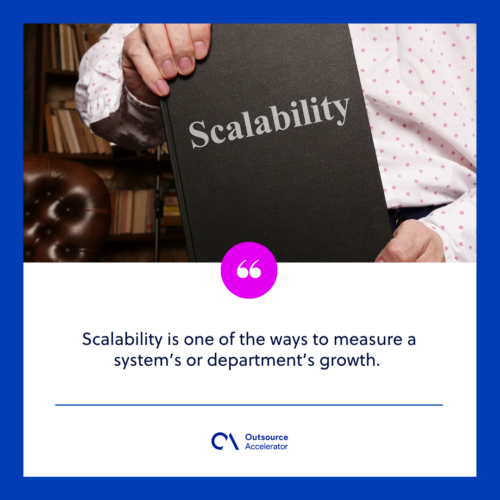Scalability
Definition
What is scalability?
Scalability is one of the ways to measure a system’s or department’s growth. It refers to the ability of the component to adapt to changes and the upsurge of demands that go through the system.
From systems and applications to departments and other business units, scalability can be considered a key factor in gauging how businesses can reach their full potential.

Three types of scalability
Scalability can be measured in three ways, namely—horizontal, vertical, and team scaling. And they can all happen simultaneously in an organization or department.
Vertical growth
Both machines and software can scale up vertically. This type of growth refers to adding more resources to a single component to accommodate the surge of demands that come through.
For instance, a computer with 8 GB of random-access memory (RAM) can be upgraded to 16 GB to accommodate all the programs that are open simultaneously.
Horizontal growth
Also known as scaling out, this type of scaling refers to adding more components to cater to the demands. Horizontal scaling can be applied both to machines and software.
For example, if the data center of a software-as-a-service (SaaS) platform is always running into a “server is full’ error, then the next step is to add another server to the center. This way, people and businesses can still use the platform more smoothly.
Team expansion
The demand for productivity in the workplace and getting more work done can be met by expanding the team by a few members. Hiring new talents can be beneficial for everyone involved—with new people come new talents and skills to add to the roster.
How businesses optimize for scalability
Companies often optimize their businesses for future growth, and planning and strategizing are crucial to this. Here’s how a business can do it.
Expanding services
By providing new services and updating existing ones, businesses can entice new customers and gain loyal ones. With this, demands will surely skyrocket, making it easier to scale up.

Maximizing available resources
Maximizing resources until all of them are used can be the first step in scaling up. By doing so, the company can save money and have plenty of time to think about their next development.
Exploring other options
Scalability can mean introducing flexibility in the workplace. Exploring other options can be beneficial for companies that are actively looking out for new things to try and trends to conquer.







 Independent
Independent




